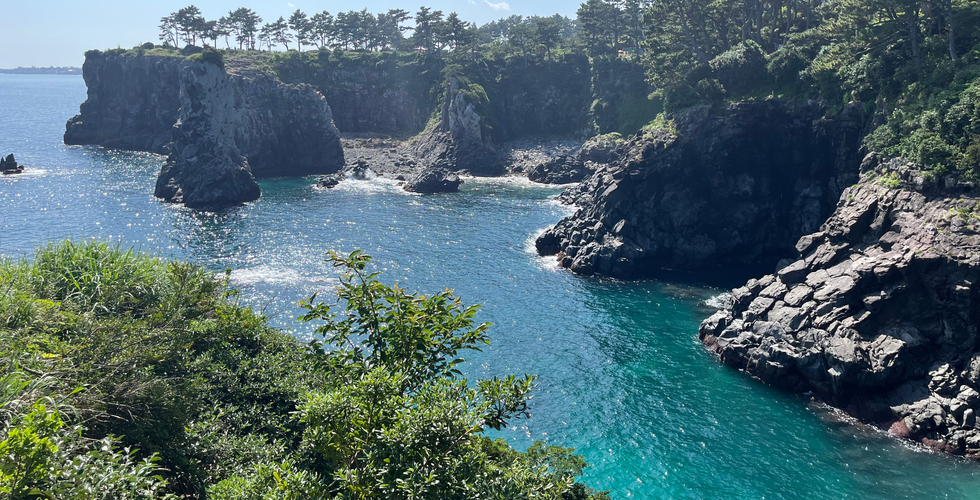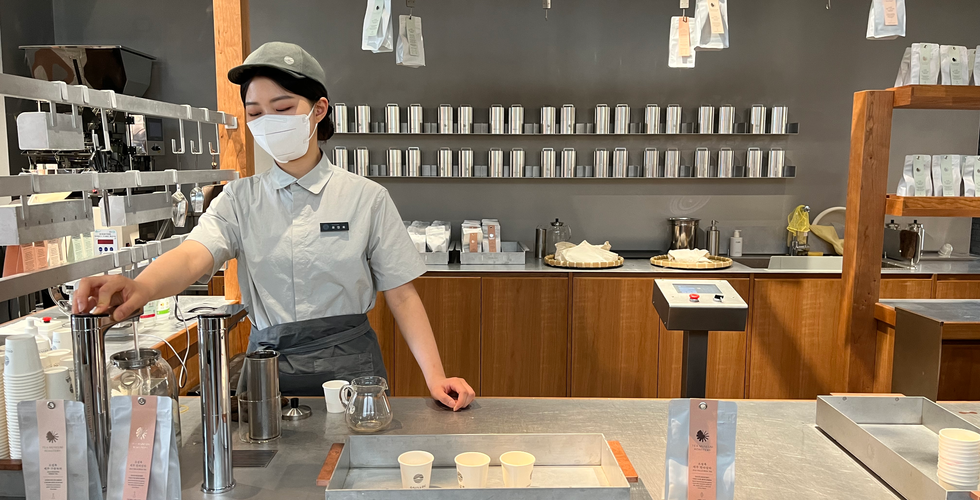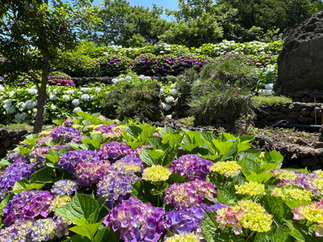Jeju Island, one of a kind
Updated: Oct 31, 2023
Before living in South Korea, I knew nothing of Jeju Island (제주도). Once I got here though, whenever I would ask for sightseeing suggestions it always came up: “You must visit Jeju!”. So, I did! In early June Eddie and I took off to Jeju on a 4-day getaway that would unravel one of Korea’s hidden gems.
Located at about 80km south of the Korean Peninsula, Jeju is accessible by flight or even by ferry, if time is not of essence. When we landed in Jeju City, in the northern part of the island, it was raining heavily, heads-up of the hot and humid subtropical summer that was in the making. Luckily, this was the worst weather spell we had, and, for the rest of our stay, we had plenty of sun and clear skies, allowing us to fully enjoy the scenery the island is so famous for. We rented a car from the airport, the best way to get around the island, and headed south, eager to explore this small piece of land, that everyone is talking about.
From a satellite view, the oval shaped island, measuring about 73km east-west and 31 km north-south, looks like a huge base for the centrally placed Mt. Halla (한라산), a dormant volcano, which, at 1950m, is the tallest mountain in South Korea. Surrounded by the three big seas: Yellow Sea, East China Sea, and Sea of Japan, Jeju was formed by the eruption of an underwater volcano approximately 2 million years ago. The seabed must have gone through quite a bit of work to form Jeju as there are another 360 parasitic volcano cones, known as “oreum” in Jeju dialect. On top of that, almost 10% of the island’s area is covered by an intricate labyrinth of volcanic lava tubes, a sought-after destination for today’s scientists and tourists, and an underground passage in the past wartimes.
The island’s geological value and unique ecology have been recognized worldwide in 2007 when UNESCO World Natural Heritage enlisted, under the title “Jeju Volcanic Island and LavaTubes”, three of its most important sites: Mt. Halla protected area, Seongsan Ilchulbong and Geomunoreum Lava Tube System.
Although we wished to see them all, we knew we wouldn’t have enough time, so we started our trip with Jeju World Natural Heritage Center, a great place to start learning about the island, on foot and from expositions. Located on the Geomunoreum (거문오름) Lava Tube System, the centre is the starting point of few trails that traverse the pristine forest that covers the slopes of the Geomun volcanic cone, a quiet invitation we couldn’t pass. It was still foggy in the morning we hiked the 1.5 hour trail, the shortest of all, but it was then when I felt we’re out of the big city: the misty air, the rich greenery, and the quietness of the forest were filling my lungs with fresh air and quieting my mind.

On our hike we passed by a few volcano lava tubeopenings, but we couldn’t enter in any of them as it is too risky. As a matter of fact, only a few are accessible to the wide public, among which Manjanggul (만장굴) is the most spectacular.
We compensated by visiting the centre and its displays about Geomunoreum volcanic formations.
We left the National Heritage Center in the guard of three “Dol hareubang” ( 돌 하르방) . The “grandfather” statues, carved out of volcanic stone(basalt) and typically placed around a gate entrance, are considered gods offering both protection and fertility. While their origin is disputed, they became a symbol of Jeju and they can be spotted often on the island, coming in different sizes. Not surprisingly they are also a popular presence in the souvenir shops, as textile imprints or small replicas.

We wanted to check one more UNESCO heritage site and headed towards Seongsan Ilchulbong (성산일출봉), also known as the “Sunrise Peak” for the beautiful sunrise views one can see from its top. The hydromagmatic volcano, another world geological treasure, has risen from a shallow seabed following a series of volcanic eruptions about 5 million years ago. Its tuff cone, with a bowl like crater, is the most well preserved of its kind in the world, making it extremely valuable for studying old geological structures.
Scientific value aside, the cone feels kind of … extra-terrestrial. Even though I had seen pictures of it ahead of our trip, I was still stunned by the view that opened in front of me after reaching the top: a huge green bowl, surrounded by the blue sea, deep from the top and high from the bottom. I really wished I could fly in that moment to be able to see it all close up! No amateur pictures make it justice so I’m throwing in a picture of the entrance ticket as my last resort.
I was taking breaks quite often as went up and down on the mixed wooden and stone staircases, but it wasn’t because of the early afternoon heat, as the clear sky and cooling breeze made the short hike quite pleasant. It was because I wanted to delay the moment we would leave that place; it was because I wanted to absorb the beauty of the sea and the old stones and take a memory imprint of the spectacular panoramic views that were unfolding in front of us. Strange lava formations were accompanying our path, prompting me to pause and look at them, as if they wanted to pass along the legends they carried on for centuries.
Jeju Island is a favourite honeymoon and vacation destination for Korean and foreign tourists alike. But well before it got to be marketed as the “Hawaii of Korea”, the island was known for its strong winds and strong women.
As we drove through older residential areas, low height lava stone walls accompanied the side of the road or surrounded the houses and their courtyards. The walls, similar to the ones from pictures below, were made of porous lava stones, free standing on top of each other, without any mortar in-between. Somehow, the pierced walls would withstand and slow down the strong winds and protect the households.
And, if the Jeju walls tamed the winds gusts, its women seemed to have tamed the sea! For hundreds of years, a small group of women on this island have made a living by harvesting seafood by hand, from the ocean floor. They are known as “haenyeo” (해녀) or “sea women”. They typically go for 1-2 min dives, up to 10 m deep, with no breathing equipment, wearing old-fashioned scuba diving googles, rubber wet suits and flippers. They use lead weights strapped around their waist to dive faster, a sharp tool to help them remove the abalone, sea urchin, conch, or some other seafood from the seafloor, and a yellow-orange flotation device that holds a net for keeping the harvest.
After descending from Ilchulbong, we continued walking along the east side of the steep shoreline of the Seongsan peninsula, scrutinizing the sea wide and far, looking for the yellow floatation devices, the sign of haenyeo at work. Locals told me “they are everywhere”, but that can’t be true, I thought. When I did spot the floatation devices and the women divers themselves, I couldn’t believe it! They were in a small golf, right at the bottom of the cliff. We were lucky to catch them just finishing up a short demonstration session that they had for the public. It was humbling to see these women, some in their late sixties or older, seemingly fragile yet very strong. Their skin showed the many years of sun, sea, and wind, but their eyes were as deep and calm as the sea on that day.
The sea harvesting has been a source of food and income for the Jeju women for hundreds of years, but as more sources of income opened, their number started to decline. Currently, most of them are over 50 with the oldest being in her 80’s. Traditionally they would start training in their teens, with short and shallow dives, gradually advancing to more challenging ones. It takes a new apprentice about seven years to become a full fledged haenyeo, the most experienced being able to dive up to 30 meters and hold their breath for 3 min. Along with the diving and search of the seafood, they also learn to read the sea and its currents, the wind, and the sun. This knowledge, a treasured inheritance, is passed on through generations with matriarchal care. The women divers of Jeju take big pride in their craft, and they don’t perceive it as being hard or dangerous, even though it is. Many choose to dive for as long as they physically can and, even when they retire, in their eighties or late seventies, they miss it.
As we left the area, I kept looking far into the horizon, searching for floating devices. Sure enough, I could see more, tucked away in areas that seemed inaccessible to us, people of the land. We can only hope that the women divers of Jeju will be able to carry on their unique craft for longer than they have been around. Thankfully, their lifestyle has been recognized by UNESCO and, since 2016, it has been part of the UNESCO’s Intangible Cultural Heritage of Humanity Representative List, a testimony of their legacy to our world.
There was more to explore on the eastern side of Jeju, but we decided to spend some time on the southern part as well. Our intent was to visit the Cheonjeyeon Waterfall (천제연 폭포) however, not paying close attention to the name, we ended up at the

Cheonjiyeon Waterfall (천지연 폭포), also a very popular attraction. The waterfall, whose name literally means “sky connected with land” is located inside a park, at the end of a path that took us through a natural subtropical habitat setting, home to many species of plants and fish, among which some are considered natural monuments.
A short drive from the waterfall took us to the Odolgae Rock (외돌개). The volcanic rock, standing lonely in the middle of the sea, at an impressive 20 m height and approximately 10m circumference, has also been called The Independence, The Grandmother, The General, depending on the legend that tried to explain its mysterious shape and presence. As I look at it, standing on one of the high cliffs that are hugging the shoreline, I feel humbled by the majestic beauty that surrounds me: the cloudless sky blends in the horizon with the calm sea, as near by the bright blue water shines in the bright sun, with emerald undertones. Here too, I think, the sky connects with the land and water, in perfect harmony.
After a short walk, on a well built wooden pathway that goes quite a long way along the shoreline, we took the less smooth route of the volcanic shore and headed towards the Hwanguji (황우지) Natural Pools. In contrast with the quietness of the cliff tops, the place was lively and full of people eager to go for a swim or soak in one of the natural pools. I couldn’t resist either the temptation to dip my toes in the water. As I sat down on the porous rock, rather uncomfortable, I was happy as a kid. Not sure whether it came from the little puddle or the joy that was surrounding me, but it was a good feeling.
One good thing that often happens when we wonder around, either on purpose or by accident, is to run into unexpectedly beautiful places or situations. This time as well, after misreading the name of our intended waterfall destination, we decided to take a detour towards the sea and find a place to have lunch. This is how we found Hanghaejinmi (항해진미), a seafood restaurant with a fabulous water view and a modern interior design and ambiance. As we looked far away at the white sandy beach and the surfers were braving the waves, our sashimi order came: the exquisite arrangement looked like a sea offering on an ice bed. It is here where I decided to try the famous buckwheat noodle cold soup Mul Naengmyeon (물냉면), which is typically eaten in the winter. Not being used to cold soups, I was a bit skeptical that I would go beyond the first spoon or two, but I simply couldn’t have enough of it. The buckwheat noodles complemented nicely the slightly iced seafood broth, turning this dish into a very refreshing and nutritious meal. Why did I wait so long to try it out?
Not so fancy but equally memorable was our lunch at a small joint on our way to Seongsan Ilchulbong. The area of town where we stopped only had a handful of small restaurants, typically ran by one or two people. Being lunch time, they were overwhelmed, and the typical waiting time was about an hour. We felt really lucky when we found this grandma’s gimbap place, Odeori Gimbap (오드리 김밥) with a 20 min waiting time. The small eatery had its walls covered by numerous pink and purple post-it notes, whose content I could understand but seemed to be joyful. There only one lady that was running the place and she prepared everything by herself. We had a warm seafood soup, vegetarian and a Jeju pork gimbap, all very tasty and nicely presented.
Food wise, we were aware of two Jeju must-have’s: the black pig and the tangerines, albeit not together as a dish.
A Jeju native breed, the black pig meat tends to be redder than the typical pork and is used in multiple native dishes. We decided to go the full nine yards on that and had it at “Jeju Seon the Black”, at Shinwha World Marriott Resort, a Teppanyaki restaurant which prides itself being very unique for the "192 hours wet-aged Jeju Black Pork". The meat cuts contained layers of fat which melted nicely on the hot coal barbecue; the taste did have the typical sweetness of the pork meat, but more flavoured; its texture was interesting, a mix of slightly chewy and tender, yet melting in your mouth while eating. The set menu also included local seafood, prepared to perfection and elegantly presented.
When we ran into local stall on the side of the street that was selling tangerines, we thought this should be the best place to get them, and we were right: ripened on the tree, they were sweet and flavoured, juicy, and easy to peel. Back in time, tangerines were only grown in Jeju and a family would be considered rich if they had a tangerine tree. With larger plantations, in Jeju and outside the island, it’s not the case anymore, however, even nowadays people are looking to buy tangerines from Jeju, as they are still the best tasting ones.
As we drove around I couldn’t help noticing the abundance of museum signs. Well, it turns out that Jeju has about 100 museums of all sorts: folklore, haenyeo, art, history, collectible cars, love, teddy bear, and the list goes on.
As a tea lover that has never seen a tea plantation, I had to see the O'sulloc Tea Museum (오설록 티뮤지엄). Located next to the O'sulloc's Seogwang Tea Planation, the modern building has an impressive architectural design. Featuring wooden structures and huge windows, the indoor open space was well lit, blending within the surrounding nature. While the tea plantation was a real treat, there wasn’t much of a museum otherwise; a simplified replica of a tea manufacturing line and a small exposition were providing insights in the tea processing. The souvenir and coffee shops occupied most of the indoor area and they were all packed.
Nearby, there is an equally beautiful building hosting Innisfree products, a cosmetic brand based on natural plant ingredients and Jeju volcanic soil; I quite like this brand, soooo I did what any girl must do in this situation: shop!
One of the best times to visit Jeju is spring, during the blooming season, when the wild nature, theme parks and gardens are overflowing with colour. It was past blooming season in early June, but we still got to enjoy the most beautiful hydrangea garden at Norimae (노리매) Park, along with the flower gardens and citrus fruit trees, the lily covered pond and its delicate wooden pavilion.
On our last day we drove along the west side of the island, which seemed somehow quieter and more pristine, with the charcoal volcanic stone shorelines welcoming the shallow, emerald waters.
We stopped to get a coffee at the café guarded by a smiling grandpa lying down and noticed the wind mills rising from the sea; Jeju people are now harvesting the wind, not fighting it anymore.
We ended our trip with a visit at local Jeju Dongmun Market, in Jeju City, in search for a bite to eat. The stalls were overflowing with fresh seafood and fruits, and the cooking was literally on fire.
Jeju Island, risen from the sea, grown out of hot volcanic lava, inhabited by humans since the early Neolithic period, is standing out strong despite the natural or human storms that came upon it. I will remember it mostly for its raw beauty, with its rough shores and emerald waters, for its welcoming people.
My wish, as I board the plane, is to be back and take a good look at the island from the top of Mount Halla!
How about you? You must visit Jeju! After all, it is picture perfect, isn’t it?












































































































































Wow another excellent post on awesome adventures in Korea. Who is this Eddie guy?
Once again just a wonderfully written travel blog! Such great pictures (yes to the fire cooked lobsters!). Jeju is a magical place of convenience for many kdramas. Our Blues is highly recommended and it is composed of stories of different, connected people in Jeju including the women divers.
I have heard of cold noodle soup and never of interest, but after your description it is on my list.
Had been looking forward to your next post and it didn't fail my expectations!“
Thank you and keep them coming from your next place!
Thank you tour guide Cristina! What a beautiful place!